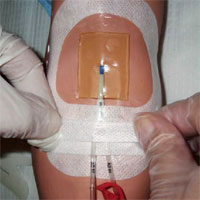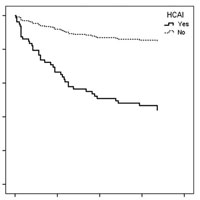Tag: infection

Variation in Identifying Sepsis and Organ Dysfunction Using Administrative Versus Electronic Clinical Data and Impact on Hospital Outcome Comparisons
Variation in the accuracy of claims data for identifying sepsis and organ dysfunction limits their use for comparing hospitals' sepsis rates and outcomes. Using objective clinical data may facilitate more meaningful hospital... read more

Practical Management of Invasive Candidiasis in Critically Ill Patients
The heterogeneity of this patient population necessitated the creation of a mixed working group comprising experts in clinical microbiology, infectious diseases and intensive care medicine, all chosen on the basis of their... read more

Sustained reduction of catheter-associated bloodstream infections with enhancement of catheter bundle by chlorhexidine dressings over 11 years
The addition of chlorhexidine dressings to all CVC and arterial lines to an ongoing catheter bundle was associated with a sustained 11-year reduction of all catheter-associated bloodstream infections. This large real-world... read more

How and Whom to Monitor for Seizures in an ICU
Prevalence of seizures detected by continuous electroencephalography was significantly higher than with routine electroencephalography. Prevalence was particularly high in post convulsive status epilepticus, CNS infection,... read more

The Glutamine Debate in Surgery and Critical Care
Three recent meta-analyses have confirmed traditional glutamine (GLN)-supplemented (or "GLN-Complemented" – providing GLN for completeness of amino acid content) TPN is safe, reduces mortality and improves outcome in surgical... read more

How to Deal with Severe Acute Pancreatitis in the Critically Ill
Management of severe acute pancreatitis (SAP) is multimodal with emphasis on monitoring, adequate fluid resuscitation, avoiding prophylactic use of antibiotics, cause-directed procedures or treatment, and organ support. There... read more

Defining Sepsis on the Wards
The aim of this study is to look at the prevalence (commonness) of sepsis across acute hospitals (hospitals with an emergency department) across Wales using the currently used and new definitions of sepsis. Sepsis is a major... read more

New Approaches Reduces Inappropriate Antibiotic Usage
A UC Davis study of 9 emergency departments and urgent care centers in California and Colorado found educating physicians and patients about safe antibiotic use can cut overuse by 30%. The study, funded under a contract from... read more

Post-discharge Impact of Healthcare-associated Infections in a Developing Country
The impact of healthcare-associated infections (HCAIs) on in-hospital mortality, morbidity, length-of-stay, and costs has been extensively reported. However, few studies have focused on the follow-up of HCAI-affected subjects... read more

Antibiotics for Sepsis
Antibiotics for Sepsis - Does Each Hour Really Count? Or is it Incestuous Amplification? - by Prof Mervyn Singer "Each hour's delay in initiating antibiotics costs lives" is a doctrine that has attained quasi religious status.... read more

In-hospital Mortality Associated with the Misdiagnosis or Unidentified Site of Infection at Admission
Rapid detection, early resuscitation, and appropriate antibiotic use are crucial for sepsis care. Accurate identification of the site of infection may facilitate a timely provision of appropriate care. We aimed to investigate... read more

Identifying At-Risk Patients for Sub-optimal Beta-lactam Exposure in Critically Ill Patients with Severe Infections
Conventional beta-lactam dosing is flawed in critically ill patients. Useful tools such as the MeroRisk Calculator need to be comprehensively evaluated clinically, and if successful should be added into clinical practice... read more

The Epidemiology of Symptomatic Catheter-associated Urinary Tract Infections in the ICU
Catheter-associated urinary tract infection (CAUTI) occurs frequently in critical illness with significant morbidity, mortality, and additional hospital costs. The epidemiology of symptomatic ward-acquired CAUTI (within 48... read more

Environment key battle ground in fight to tackle antibiotic resistance
The environment could be as important a battle ground as the clinic in the global fight against the spread of antibiotic resistance, new research has shown. A study conducted at the University of Exeter Medical School concluded... read more








